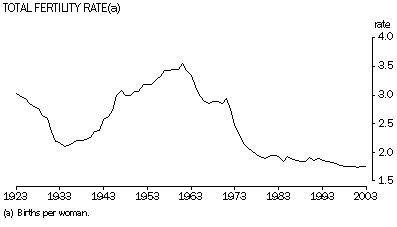ABOUT THIS PUBLICATION
This publication brings together statistics and indicators for births in Australia.
DATA IN THIS PUBLICATION
This publication contains birth registration data for live births, except where otherwise stated. Populations used in the calculation of rates for 2003 are the preliminary estimated resident population by age and sex at 30 June 2003. Unless otherwise stated, state or territory relates to the state or territory of usual residence.
Due to a delay in birth registrations in December 2000 brought about by system, processing and legislative changes affecting the Tasmania birth registration form, the number of births registered and the total fertility rate for Tasmania in 2001 appear high when compared with 2000 data.
ROUNDING
In commentary based on the statistics in this publication, it is recommended that the relevant statistics be rounded. All data are affected by errors in reporting and processing. Birth registration data are also affected by delays in registration. These data have had small values suppressed to protect confidentiality. No reliance should be placed on statistics with small values.
INQUIRIES
For further information about these and related statistics, contact the National Information and Referral Service on 1300 135 070 or Joanna Forster-Jones on Canberra (02) 6252 5117.
SUMMARY COMMENTARY
FERTILITY RATE STEADY
- Australia's total fertility rate (TFR) in 2003 was 1.75 babies per woman, slightly lower than in 2002 (1.76). Over the past six years the TFR has been relatively stable, varying between 1.73 and 1.76 since 1998.
- For the fourth consecutive year, women aged 30-34 years experienced the highest fertility of all age groups, with a rate of 113 babies per 1,000 women. Women aged 25-29 years experienced the second highest fertility in 2003 (103 babies per 1,000 women).
- Fertility rates for 20-24 year old women continued to decline during 2003. Fertility for this age group has almost halved over the past two decades, from 103 babies per 1,000 women in 1983 to 55 babies per 1,000 women in 2003. Fertility of women aged 25-29 years has also fallen, from 146 babies per 1,000 women in 1983 to 103 babies per 1,000 women in 2003. Fertility of women aged 35-39 years has more than doubled over the past two decades, from 25 babies per 1,000 women in 1983 to 54 babies per 1,000 women in 2003.
- The Northern Territory recorded the highest TFR in 2003 (2.38 babies per woman) while the Australian Capital Terrritory recorded the lowest (1.60).

- In 2003 there were 251,200 births registered in Australia. This was a slight increase (200 births) on the number registered in 2002, and the highest since 1997.
- Western Australia recorded the largest increase in births in 2003 (up 700 over the number registered in 2002) followed by Queensland (up 600). Small increases were recorded in the Northern Territory and the Australian Capital Territory, while there were fewer births in New South Wales, Victoria, South Australia and Tasmania.
INDIGENOUS BIRTHS AND FERTILITY
- There were 11,700 births registered in Australia during 2003 (5% of all births registered) where at least one parent was identified as Indigenous.
- Indigenous women have a higher TFR (2.15 babies per woman in 2003) than all women (1.75 babies).
- Indigenous women in the Northern Territory experienced the highest fertility (2.83 babies per woman).
- High fertility at younger ages contributes to the relatively high fertility of Indigenous women. In 2003, women under 30 years of age accounted for almost three-quarters of the Indigenous total fertility rate, compared to half of the fertility rate for all women in Australia.
- For Indigenous women, the peak fertility was is the 20-24 year age group (133 babies per 1,000 women), followed by women aged 25-29 years (111 babies).
- The median age of Indigenous women who registered a birth during 2003 was 24.6 years, almost six years younger than the median age of all women who registered a birth in 2003 (30.5 years).
 Print Page
Print Page
 Print All
Print All